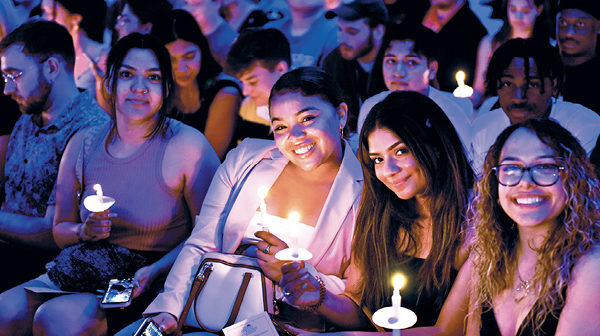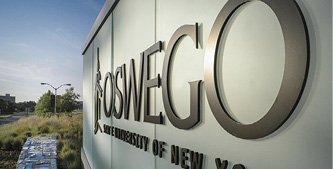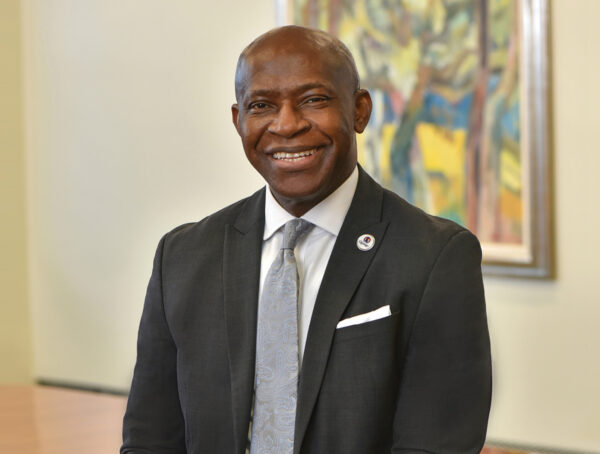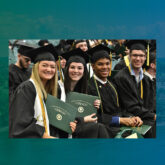Golden Opportunity: New Director Ushers In Post-Pandemic Recruitment Era
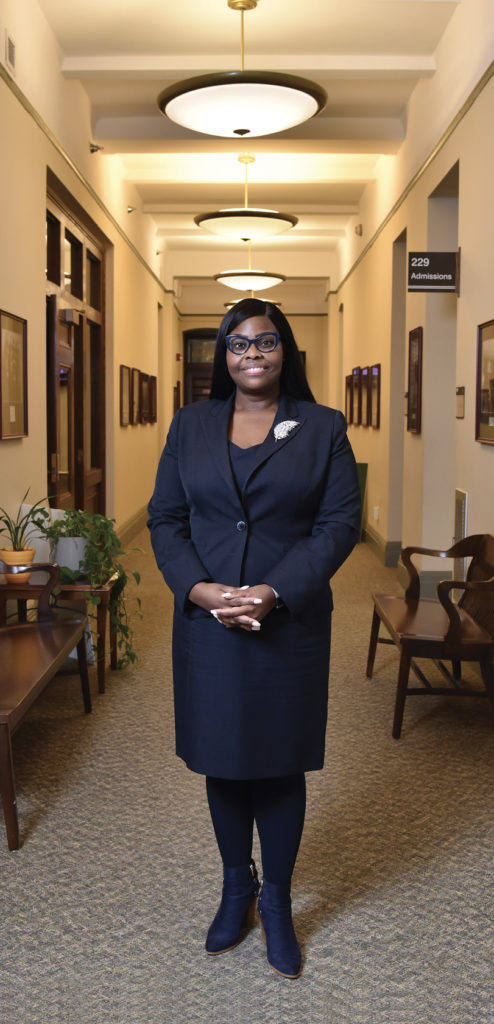
Ebony Dixon, executive director of enrollment management
When Ebony Dixon accepted the new executive director of enrollment management role at SUNY Oswego, her then-boss sent her pictures of snow for several days in a row, asking her if she was sure she wanted to leave her position at Southern Methodist University in Dallas, Texas.
“I said, ‘Yes, sir. I’m certain,’” Ebony said. “I kept all my winter clothes. They were just in the garage, in the packing boxes, so I was ready. I’ve not had to buy anything new.”
A native of Cleveland, Ohio, who completed her undergraduate degree and two master’s degrees at Wayne State University in Detroit, Mich., Ebony said a little snow and cold couldn’t scare her away from the opportunities presented in this role at Oswego.
She moved to Syracuse and began her tenure at Oswego in mid-September.
As the college’s chief enrollment officer, Ebony serves as a member of the President’s Council; oversees the Admissions operations of the college; and provides leadership to strategically plan, develop, coordinate and implement SUNY Oswego’s comprehensive enrollment management and retention efforts.
Under the leadership of President Deborah F. Stanley, SUNY Oswego has been adapting its recruitment strategies to respond to a declining number of young people enrolled in elementary, middle and high schools in New York state, particularly in Central and Northern New York, and across the Northeast for decades.
The college hired Admissions counselors specifically to recruit downstate in New York and Long Island and in New Jersey. More recently, the college has developed stronger connections to schools in Washington, D.C., and other regions with higher density of college-bound students. It sought to develop the student pipeline to higher education through programs with high schools and community colleges.
The college has been successful in recruiting diverse, talented classes to study and live on campus. Despite the uncertainties presented by the COVID-19 pandemic, SUNY Oswego’s enrollment for Fall 2020 was 7,636 students—6,673 undergraduates and 963 graduate students—approximately 200 fewer than in Fall 2019. Data for Spring 2021 total enrollment looks nearly on par with Spring 2020 figures.
Hopeful Prospect
Despite the challenges of shrinking college-age students in the Northeast and the strains that the COVID-19 pandemic has put on the state budget and the ability to showcase our stunning lakeside campus via in-person tours, Ebony remains optimistic about recruitment and is motivated to transform the challenges into opportunities.
“This is really an opportunity to have a broader reach with students,” she said. Among the student populations she hopes to target for recruitment are those seeking to transfer or finish a degree, first-generation students and out-of-state students.
Rather than spending money on airfare, car rentals and per diem, Admissions staff members can be in their offices and meet with students in Chicago at 9 a.m., in Washington, D.C., at 10 a.m., in Texas at 1 p.m. and wherever else at 2 p.m., she said.

Ebony Dixon, executive director of enrollment management
“As an example, we hosted our open house for prospective students and their families,” she said. “Because of the pandemic, we couldn’t host them on campus so we pivoted that program to a three-day, virtual open house. We had wonderful results. We had the highest show rate for any open house we’ve had. Several of the students were from out of state.”
The virtual realm is showcasing the college to students and their families who previously wouldn’t have considered spending the money and time to visit the campus. For those who make the effort to tune in to yet another Zoom call, Ebony said she wants to make it worth their time.
“They’re in high school or community college all day at the computer,” she said. “The last thing they want to experience is one more virtual event. That’s why it has to be a spectacular event. If they have honored us with their presence by logging in, let’s make it a human emotional experience for them—something that they can create a memory with.”
Personal Connections
That’s where the student Admissions representatives, faculty and alumni can make a big difference.
The most popular portions of the Open House events are the “Ask Me Anything” panel with current students and the student-led virtual tour of campus, Ebony said.
“There’s nothing like peer-to-peer engagement,” she said. “That’s why we include our students in everything we do. They are instrumental in our daily decisions and daily discussions.”
For example, when prospective students were not opening their emails or attending events promoted by emails, Admissions staff turned to their student workers. What would they want to receive—a phone call? A text message? A hand-written note? A tweet?
“Each of them said, ‘Send me a text message,’” Ebony said. “We have our Admissions students on the line when we do recruitment presentations and open houses. They are essential. We need delightful, exciting, enthusiastic tour guides to share their stories.” (See related story.)
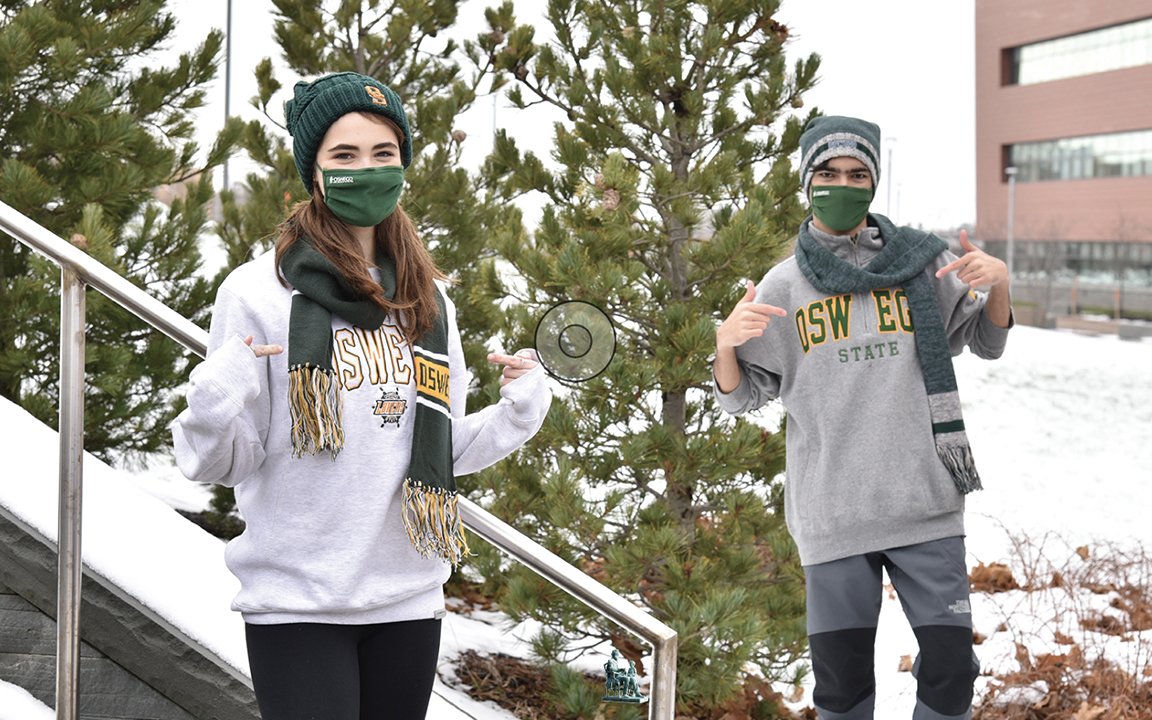
Rhiannon Bonawitz ’22 (left) and Kaushal Joshi ’21 are among the team of student Admissions representatives who serve as tour guides and panelists on the popular “Ask Me Anything” portion of Admissions events.
A three-year student Admissions representative Gabriele Candela ’22, who is a double major in public relations and graphic design, said with the shift to the virtual realm she has taken on a larger role with managing the Admissions social media accounts, but her goal remains the same.
“I hope to provide prospective students and their families with a lasting impression of Oswego so that it stands out in their college decision process and they remember it in the best ways possible,” she said. “I want to be as transparent and relatable as possible so that they can really picture themselves as an Oswego student. I get to share a little bit of my story and why I love Oswego and use that to help prospective students navigate their decision. It’s truly the best job!”
Faculty and staff members also assist Admissions staff members in connecting with prospective students and encouraging them to apply and then commit to Oswego.
An increasingly engaged population in Admissions work is the network of 89,000 SUNY Oswego alumni. Last spring, alumni volunteers reached out to admitted, undeclared students and their parents to share their Oswego story and encourage the prospective students to commit to Oswego.
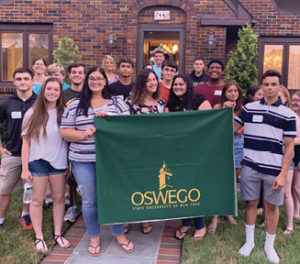
Michael ’83 and Joanne Snyder Durney ’84 hosted a Summer Sendoff Reception at their Long Island home (pictured above) for 50 students and their parents as well as two alumni ambassadors.
In summer 2019, alumni, in coordination with Admissions, hosted two Summer Send-Off Receptions for students who were about to begin their college journeys at SUNY Oswego. The first was hosted by Michael ’83 and Joanne Snyder Durney ’84 at their Long Island home for 50 students and their parents as well as two alumni ambassadors, and the second was held in New York City and included 124 students and their parents as well as eight alumni ambassadors.
“What a warm welcome that is for students to be invited into the home of alumni and listen to alumni talk about their Oswego experiences,” Ebony said. “That resonates with students and their families, and lets them know that our alumni are people they can call on should they need.”
Ebony hopes to continue the in-person alumni residence receptions once it is safe to do so, but in the meantime, she plans to incorporate alumni volunteers into the virtual events.
“I invite any and all alumni to get involved,” she said. “Talk about the experiences you had here—the projects you worked on, the friendships you made, the special connection you had with a faculty member or advisor. Let them see that you were once in their shoes and that it’s OK if they don’t have all the answers right now.”
A Residential Campus
An enduring goal, despite the pandemic, is to encourage students to live and study on campus.
A survey of Oswego students in May 2020 about their experience during the shift to remote instruction in March 2020 showed that being on campus could be a great equalizer in removing barriers to learning for students from all socioeconomic and racial/ethnic backgrounds. By living on campus—even if students are taking coursework online—they have equal access to high-speed internet, healthy food, safe housing and appropriate study space, according to a report by SUNY Oswego’s Office for Institutional Research and Assessment.
“While some will argue that the shift to remote instruction nationwide has rung the death knell of residential college, what COVID-19 has in fact highlighted is the vast disparities in our cities and states which make a residential college experience even more critical in the effort to fully educate all citizens,” the report stated. “The campus may want to consider developing plans to allow as many students from low-income families and communities as possible to remain safely on campus even if in-person instruction must be terminated again in the future.”
In addition to enabling better academic outcomes for students, living on campus also enriches the lives of students on a personal level.
“Students want to be here on campus,” Ebony said. “They really want to connect to campus. They want to meet their future best friends. They want to create that bond with their classmates, but also faculty members. There’s nothing like being on a college campus. There’s a vibe that happens and it keeps you young, it keeps you engaged. It’s just a delightful place to be for learning and living. Think of the interactions that happen in class, on a research project or even in the dining halls.
“You might meet somebody sitting at the lake one day,” she said. “You had no idea who they were but you leave that exchange knowing their name, knowing their Twitter handle. A new relationship is formed.”
Those human connections and relationships are an integral part of the college experience. Ebony said that is why this work energizes her and that she was born to do it.
As a first-generation college graduate herself, she said she recognizes the impact her college experience has made on her life trajectory.
“I see my work as a way to give back,” she said. “I want to set students up for success. I’ve dedicated my life to really helping students who might not have thought that they were capable of doing college coursework and also those who were. I want students to know that they can always come to my office and see me as someone who is willing to help them figure out the answers that they need. Now I might not know all the answers, but I am willing to help them navigate through the college together. We can do it together.”
You might also like
More from Featured Content
Vision for the Future
VISION for the Future Peter O. Nwosu began his tenure as the 11th president of SUNY Oswego, building on the solid …
Envisioning the Potential in All Students
ENVISIONING the Potential in All Students Educator donates $2 million in recognition of his Oswego education, in support of future teachers Frank …
A Vision of Support
A VISION of Support Award-winning principal makes an impact on her school through her positivity and commitment When Nicole Knapp Ey ’02 …







